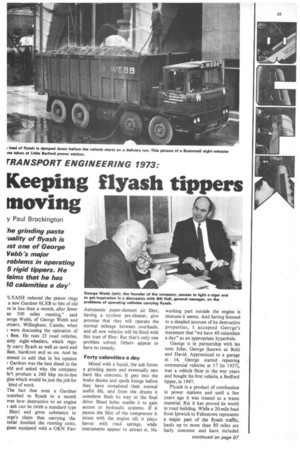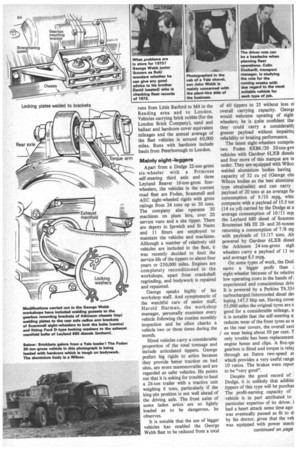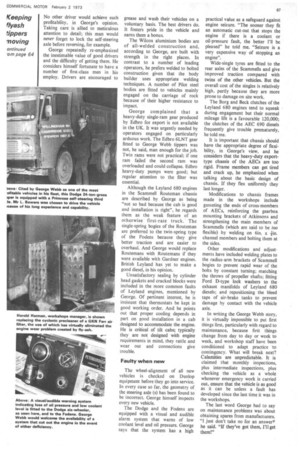Keeping flyash tippers moving
Page 65

Page 66

Page 69

If you've noticed an error in this article please click here to report it so we can fix it.
y Paul Brockington
he grinding paste ,uality of flyash is ist one of George Vebb's major roblems in operating 5 rigid tippers. He faims that he has W calamities a day' 7LYASH reduced the piston rings a new Gardner 6LXB to bits of old re in less than a month, after fewer an 500 miles running," said eorge Webb, of George Webb and irtners, Willingham, Cambs, when were discussing the operation of
fleet. He runs 25 road vehicles, ainly eight-wheelers, which reguly carry flyash as well as sand and Rut, hardcore and so on. And he stened to add that in his opinion : Gardner was the best diesel in the irld and asked why the company In't produce a 240 bhp six-in-line One which would be just the job for kind of work.
The fact that even a Gardner :cumbed to flyash in a month wes how destructive to an engine 3 ash can be (with a standard type filter) and gives substance to Drge's claim that carrying the terial doubled the running costs. gines equipped with a GKN Farr
Autopamic paper-element air filter, having a cyclone pre-cleaner, give promise that they will operate the normal mileage between overhauls, and all new vehicles will be fitted with this type of filter. But that's only one problem solved. Others appear to have no remedy.
Forty calamities a day Mixed with a liquid, the ash forms a grinding paste and eventually sets hard like concrete. It gets into the brake drums and spoils linings before they have completed their normal useful life, and from the drums it somehow finds its way to the final drive. Bleed holes enable it to gain access to hydraulic systems. If it passes the filter of the compressor it mixes with the engine oil; it plays havoc with road springs, while instruments appear to attract No working part outside the engine is immune it seems. And having listened to a detailed account of its destructive properties, I accepted George's statement that "we have 40 calamities a day" as an appropriate hyperbole.
George is in partnership with his sons John, George (known as Bob) and David. Apprenticed to a garage at 14, George started repairing commercial vehicles at 17 (in 1937), was a vehicle fitter in the war years and bought his first vehicle, a Bedford tipper, in 1947.
Flyash is a product of combustion in power stations and until a few years ago it was treated as a waste material. But it has proved its worth in road building. While a 20-mile haul from Ipswich to Felixstowe represents a major part of the flyash traffic, hauls up to more than 80 miles are fairly common and have included runs from Little Barford to M4 in the Reading area and to London. Vehicles carrying brick rubble (for the London Brick Company), sand and ballast and hardcore cover equivalent mileages and the annual average of the fleet vehicles is around 60,000 miles. Runs with hardcore include hauls from Peterborough to London.
Mainly eight—leggera
Apart from a Dodge 22-ton-gross six-wheeler with a Primrose self-steering third axle and three Leyland Beaver 16-ton-gross fourwheelers, the vehicles in the current road fleet are Foden, Scammell and AEC eight-wheeled rigids with gross ratings from 24 tons up to 30 tons. The company also operates 30 machines on plant hire, over 20 service vans and a site tipper. There are depots in Ipswich and St Neots and 11 fitters are employed to maintain the vehicles and machines. Although a number of relatively old vehicles are included in the fleet, it was recently decided to limit the service life of the tippers to about four years or /250,000 miles. Engines are completely reconditioned in the workshops, apart from crankshaft regrinding, and bodywork is repaired and repainted.
George speaks highly of his workshop staff. And symptomatic of the watchful care of senior staff, Harold Harman, the workshop manager, personally examines every vehicle following the routine monthly inspection and he often checks a vehicle two or three times during the month.
Hired vehicles carry a considerable proportion of the total tonnage and include articulated tippers. George prefers big rigids to attics because they provide better traction on bad sites, are more manoeuvrable and are regarded as safer vehicles. He points out that it is asking for trouble to haul a 26-ton trailer with a tractive unit weighing 6 tons, particularly if the king-pin position is not well ahead of the driving axle. The front axles of some laden attics are so lightly loaded as to be dangerous, he observes.
It is notable that the use of bigger vehicles has enabled the George Webb fleet to be reduced from a total of 40 tippers to 25 without loss el overall carrying capacity. George would welcome uprating of eight. wheelers; he is quite confident thai they could carry a considerabl3 greater payload without impairini reliability or braking performance.
The latest eight-wheelers compris+ two Foden 8XB6 /30 30-ton-gvv vehicles with Gardner 6LXB diesels and four more of this marque are oi order. They are equipped with Wilco welded aluminium bodies having capacity of 32 cu yd (George cite Wilcox bodies as the best aluminiur type obtainable) and can carry payload of 20 tons at an average ful consumption of 9/10 mpg, whic compares with a payload of 15.5 tor (14 cu yd) carried by the Dodge at a average consumption of 10/11 mg the Leyland 680 diesel of Scam= Routeman Mk III 28and 26-tonne) returning a consumption of 7/8 mr with payloads of 15/17 tons. Alt powered by Gardner 6LXB diesel the Atkinson 24-ton-gross eigh wheelers carry a payload of 13 to] and average 8.5 mpg.
On some types of work, the Dod earns a bigger profit than ; eight-wheeler because of its relative low operating costs in the hands of experienced and conscientious driv• It is powered by a Perkins T6.354 turbocharged /intereooled diesel dm loping 147.5 bhp net. Having cover 55,000 miles the original tyres are s good for a considerable mileage, a it is notable that the self-steering a: reducts wear of the front tyres as soo as the rear covers, the overall savi on wear being about 50 per cent. only trouble has been replacement engine hoses and clips. A five-spe gearbox is fitted and torque is rela3 through an Eaton two-speed which provides a very useful range 10 ratios. The brakes were repor to be "very good".
Despite the good record of Dodge, it is unlikely that additio tippers of this type will be purchas The profit-earning capacity of vehicle is in part attributed to particular expertise of its driver. had a heart attack some time ago was eventually passed as fit to di by his doctor, given that the veh was equipped with power steerii No other driver would achieve such profitability, in George's opinion. Taking care is allied to meticulous attention to detail; this man would never forget to lock the self-steering axle before reversing, for example.
George repeatedly re-emphasized the inestimable value of good drivers and the difficulty of getting them. He considers himself fortunate to have a number of first-class men in his employ. Drivers are encouraged to grease and wash their vehicles on a voluntary basis. The best drivers do. It fosters pride in the vehicle and earns them a bonus.
The Wilcox aluminium bodies are of all-welded construction and, according to George, are built with strength in the right places. In contrast to a number of leading operators, he prefers welded to bolted construction given that the body builder uses appropriate welding techniques. A number of Pilot steel bodies are fitted to vehicles mainly engaged on the carriage of rock because of their higher resistance to impact.
George complained that a heavy-duty single-ram gear produced by Edbro for export is not available in the UK. It was urgently needed by operators engaged on particularly arduous work. The Edbro 6LNT gear fitted to George Webb tippers was not, he said, man enough for the job. Twin rams were not practical; if one ram failed the second ram was overloaded and could collapse. Edbro heavy-duty pumps were good; but regular attention to the filter was essential.
Although the Leyland 680 engines in the Scammell Routeman chassis are described by George as being "not so bad because the cab is good and installation is right", he regards them as the weak feature of an otherwise first-rate truck. The single-spring bogies of the Routeman are preferred to the twin-spring type of the Fodens because they give better traction and are easier to overhaul. And George would replace Routemans with Routemans if they were available with Gardner engines. British Leyland has yet to make a good diesel, in his opinion.
Unsatisfactory sealing by cylinder head gaskets and cracked blocks were included in the more common faults of Leyland engines, mentioned by George. Of pertinent interest, he is insistent that thermostats be kept in good working order. And he points out that proper cooling depends in part on good installation in a cab designed to accommodate the engine. He is critical of tilt cabs; typically they are not designed with engine requirements in mind, they rattle and wear out and connections give trouble.
Faulty when new The wheel-alignment of all new vehicles is checked on Dunlop equipment before they go into service. In every case so far, the geometry of the steering axle (s) has been found to be incorrect. George himself inspects every new vehicle.
The Dodge and the Fodens are equipped with a visual and audible alarm system that warns of low coolant level and oil pressure. George says that the system has a high practical value as a safeguard against engine seizure. "The sooner they fit an automatic cut-out that stops the engine if there is a coolant or oil-pressure fault, the better I'll be pleased" he told me. "Seizure is a very expensive way of stopping an engine".
Wide-single tyres are fitted to the rear axles of the Scammells and give improved traction compared with twins of the other vehicles. But the overall cost of the singles is relatively high, partly because they are more prone to damage on site work.
The Borg and Beck clutches of the Leyland 680 engines tend to squeak during engagement but their normal mileage life is a favourable I20,000; the clutches of the AEC 690 diesels frequently give trouble prematurely, he told me.
It is important that chassis should have the appropriate degree of flexibility, in George's view, and he considers that the heavy-duty exporttype chassis of the AECs are too rigid. Frame members can get tired and crack up, he emphasized when talking about the basic design of chassis. If they flex uniformly they last longer.
Modifications to chassis frames made in the workshops include gusseting the ends of cross-members of AECs, reinforcing the gearbox mounting brackets of Atkinsons and strengthening the main members of Scammells (which are said to be too flexible) by welding on 6in. x
channel members and bolting them at the sides.
Other modifications and adjustments have included welding plates to the radius-arm brackets of Scammell bogies to prevent rapid wear of the bolts by constant turning; matching the throws of propeller shafts; fitting Ford D-type lock washers to the exhaust manifolds of Leyland 680 diesels; and repositioning the bleed taps of air-brake tanks to prevent damage by contact with the vehicle axle.
In writing the George Webb story, it is virtually impossible to put first things first, particularly with regard to maintenance, because first things change from day to day or week to week, and workshop staff have been conditioned to adapt practice to contingency. What will break next? Calamities are unpredictable. It is claimed that monthly inspections, plus intermediate inspections, plus checking the vehicle as a whole whenever emergency work is carried out, ensure that the vehicle is as good as it can be unless a fault has developed since the last time it was in the workshops.
The last word George had to say on maintenance problems was about obtaining spares from manufacturers. "I just don't take no for an answerv he said. "If they've got them, I'll get them!"
















































































































































